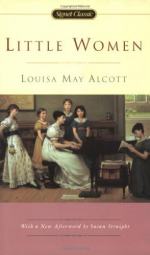|
This section contains 616 words (approx. 2 pages at 400 words per page) |

|
In Little Women, Alcott blends the children's moral tale of her day with the domestic novel, a popular form of nineteenth-century women's fiction.
The narrative structure is episodic, with alternating chapters focused on either each girl in turn, or on the group, in order to convey lessons on right behavior. Alcott lightened the moralistic tone found in other children's fiction by stressing family approval and social rewards rather than personal religious salvation. Reinforcement of the domestic theme also lightens the tone. Episodes are often festive, constructed around reunions, reconciliations, events when family life is celebrated. Moments of moral realization often revolve around conversations, which demonstrate Alcott's capacity for artfully crafted dialogue. The novel also is lighter on sentimentality than other tales.
An important aspect of Alcott's technique is realism. In Little Women, Alcott drew heavily upon her own life experiences. She built her characters around people she knew...
|
This section contains 616 words (approx. 2 pages at 400 words per page) |

|




